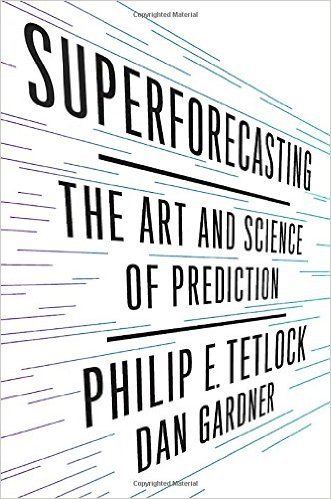The best books I have read in 2015 - Part I -(“Superforecasting: The Art and Science of Prediction”)
Can we predict the future? How far can we do this? Can our predictions be improved to become more accurate? Are there superforecasters who can predict more accurately than others? These are the questions (and others) revolving around the content of the book " Superforecasting: The Art and Science of Predicate "

Before saying that "the future can not be predicted" or "any attempts to predict will fail," I would like that it is not about "speculating" as you might think, but an extrapolation of the future based on a study of the past and the present. Just as you get a glimpse of weather conditions before you go out of your house to see if you should take your umbrella, others study a company's past before investing in its shares (predicting the company's future and investing accordingly). Other countries predict political and economic changes before Talk to prepare herself for the order well. In other words, the intention here is to extrapolate and anticipate the coming on the basis of scientific bases and studied rules.

- The forecast process is limited and has many impurities but must nevertheless be done
Prediction - as I have already mentioned - is done permanently, whether it is economic (I predict / predict the success of my project) or personality (do I expect my marriage to succeed) or others.
But a slight change here or an accident there could radically change the course of that expectation. This phenomenon is usually expressed as a "butterfly effect," which is usually summarized in such terms as "a butterfly strike on its wing in Brazil could cause a hurricane in Colorado." Just as the murder of a traveling vegetable seller in his body in a small town in Tunisia led to the fall of heads of state and the outbreak of civil wars in others.
https://qph.ec.quoracdn.net/main-qimg-b850ed2d468fb987a56dee171b55e438
But what makes certain areas accurate in their predictions while other areas are rarely accurate? The secret lies in measuring the accuracy of previous expectations and correcting the "expectation system" on them. For example, weather forecasts are very accurate (in the short term) compared to other areas, because it is an area where continuous predictions can be made (at least one prediction per day) and the feedback loop is short and fast (enough to wait 24 hours) To see if your expectation for the next day's weather is accurate). Therefore, the first key predictive principle is to measure the accuracy of expectations continuously.
- Predictions that are difficult/impossible to measure
Do not just think about the accuracy of expectations (which seems self-evident, do not you?) To improve the performance of predictions. Why do we still get false predictions permanently? The problem lies in the fact that the expectations of "experts" on a continuous basis use a language that is difficult to measure. In other words, these "experts" use rubber terms that are easy to extend and pull to include anything.
For example, the use of terms such as "Could", "Might" and "Likely" that adorn these predictions and expectations have different meanings depending on the difference of "experts" who use them, and the same expert may use them to point out two different things together. When an expert predicts that a particular event is possible or likely, one might mean that this probability is 20 percent while others might mean the probability is 90 percent.

The solution here is to push these experts to give numerical values to their expectations. When you hear, for example, that the probability of a company's share price rising 90 percent, it will give a stronger impression than the probability that it will happen only 20 percent.
- Evaluate the accuracy of the forecast and maintain the forecast register
Despite all of the above, the improvement and accuracy of predictions can not be guaranteed unless we apply the "What gets measured achieved improved" principle.
In the world of predictions there is a scale called the "Brier scale", which assesses the accuracy of predictions and gives it a value ranging from 0 (very accurate prediction fully compatible with what happened) and 2.0 (fully predictive of reality). On this scale / assessment random predictions are given a value of 0.5
To study the possibility of improving the accuracy of predictions, the author designed with a US-funded research team a study called "Good Judgment Project", which involved thousands of volunteers who answered more than a million questions (predicting certain things) over a four-year period. Questions were answered yes or no such as "Do you expect the euro to depreciate below $ 1.2 in the next 12 months?" Where the "question opens" and remains open for a period of weeks or months, and asks each participant to adjust his prediction as often as he wishes during that period. For example, one might expect the euro to fall below $ 1.2 in the next 12 months by 70 percent, then read a report in a prestigious newspaper or study and adjust its forecast, for example, to 60 percent later. With the possibility of any number of adjustments being made during the question period.
- Who are the Superforecasting?
In the above-mentioned "Good Judgment Project", a group of forecasters came up with astonishingly accurate forecasts, although most of them were forecasting in areas far from their specialties. These results prompted the project team to study closely to see the "secret" behind their precise expectations and to see if there are certain patterns that can be replicated to get the same results.
- Superforecasting divide any question into smaller, manageable parts before releasing their expectations
What distinguishes an extraordinary predictor (even if he has no experience in the field in which he is trying to predict) from the rest of the forecasters whose predictions are worse than mere random prediction (or "worse than a chimpanzee trying to hit a target with a arrow")? One of their main advantages is that they do not rush to launch general predictions without analyzing the question to be predicted to answer smaller units. This technique is usually attributed to the physicist Enrico Fermi, who is said to have asked his students (at a time when the answers were not a single click away) to expect the number of piano tuners in the city Such as Chicago without prior information or information about the order.
Fermi's goal here is to push students to follow a scientific approach in their expectations of dividing the current problem into smaller, easily controllable problems. For example, instead of answering with random numbers, the student will need to know: The number of piano players in Chicago, first, which requires the number of pianos per 1000 people plus the number of institutions that may also have piano devices.
It will then need to predict how many hours each device will need to adjust accurately. We will then calculate the number of devices that each tuner can adjust per year (after taking into account annual holidays and time to move from one device to another, etc.). Therefore, we can calculate the approximate value of the number of piano tuners that a city like Chicago needs.
But what if the liquid did not know the population of the city of Chicago from its base? Although he will make that information known, he will know that it is the third largest city in America and may know and measure the population of the largest city.
In other words, even if all this process is expectations and approximations based on the other, it will be more accurate and closer to the truth because it follows a scientific method and methodology is studied, and once the information is available from the basis of the forecast (for example know precisely the population of the city or the number of devices The piano in it), the forecast can be adjusted better to improve a more accurate prediction.
When I get to this point in the book, one of the questions that some US technology companies ask about their job applicants, such as "How much golf ball can we put in a room of such and such size" as "silly" Find out whether the applicant will only give a random number or try to analyze the question into smaller problems that can be better controlled in Fermi mode. This may not be the explanation for that, but I wanted to point out the matter here.
- Superforecasting care about the broader picture before going into detail and adjusting their expectations according to the new information they receive
Too often, too many details will take you in the wrong direction. To illustrate this idea the writer hits this example. Let us assume that you were asked to calculate the probability that an American family of Italian origin would have a family with a family, a father, a mother, a child and an grandmother, and that the head of the household was an accountant and that it worked part-time.
The error in which the public (which does not involve supernatural predictors) is to quickly analyze these data and launch an expectation on them to answer the question quickly. You might expect that once a child is at home, the likelihood of having a pet is very high.
But the supernatural predictor will take a different route. The first thing he will do is look for the proportion of American families with a pet (a quick search on Google will give you an answer and assume that it is 62 percent). Based on this information he will be able to "adjust" his expectation accordingly. Therefore, his prediction will be more accurate (because it is based on correct evidence and figures).
In other words, you must rely on general facts before trying to use any information or details that can be side-by-side to paint a more accurate picture of the issue to be predicted.
- Superforecasting do not engrave their predictions on the stone, but constantly update them

One of the distinguishing features of the supernatural predictors compared to others is that they do not "relate" much to their predictions as they continually update them based on the new information they receive. For example, if someone determines that the occurrence of an event is 60 percent and reads a news report containing new information or details that were not previously known about the matter, the supernatural predictor will update the above percentage accordingly. However, the availability of additional information does not necessarily mean that useful information is available. The forecaster may have old reports calculated by new or inaccurate data, so the issue is not merely a matter of aggregation of the largest amount of data, but also a good choice of data to be taken into account.
summary :
The idea that the book wants to convey is that extrapolating the future (in the short term) is neither talent nor fantasy. It is possible, as it depends on a scientific method based on the collection and analysis of appropriate data, keeping a record of past expectations to measure its accuracy, And to keep abreast of new events in the area in which they are being foreseen.
In my opinion, the book does not fall into the must-read category, but I label it as books that light the way for you to know things you did not already know about (ie, at least to be on Know what we do not know).
Disclaimer: This is not a summary of the book and reading this "article" can not stop reading the book.
If you would like to read the book, you can buy it on Amazon via this link: http://amzn.to/29OJa3I
Did you like this article? Tell your friends about it
--------------------------------
I spent the whole day in the research and writing in this, I hope that this post you like it, I'm sorry about the grammatical errors
you can find more here : @a-a-lifemix

This post recieved an upvote from minnowpond. If you would like to recieve upvotes from minnowpond on all your posts, simply FOLLOW @minnowpond
As a follower of @followforupvotes this post has been randomly selected and upvoted! Enjoy your upvote and have a great day!
Hey @a-a-lifemix
No more words.....
W
E
L
D
O
N
E
My dear friend....
Wel done and perfect work...
Upvoted...
Cheers~~~~~
Ha Ha Ha... vallagse